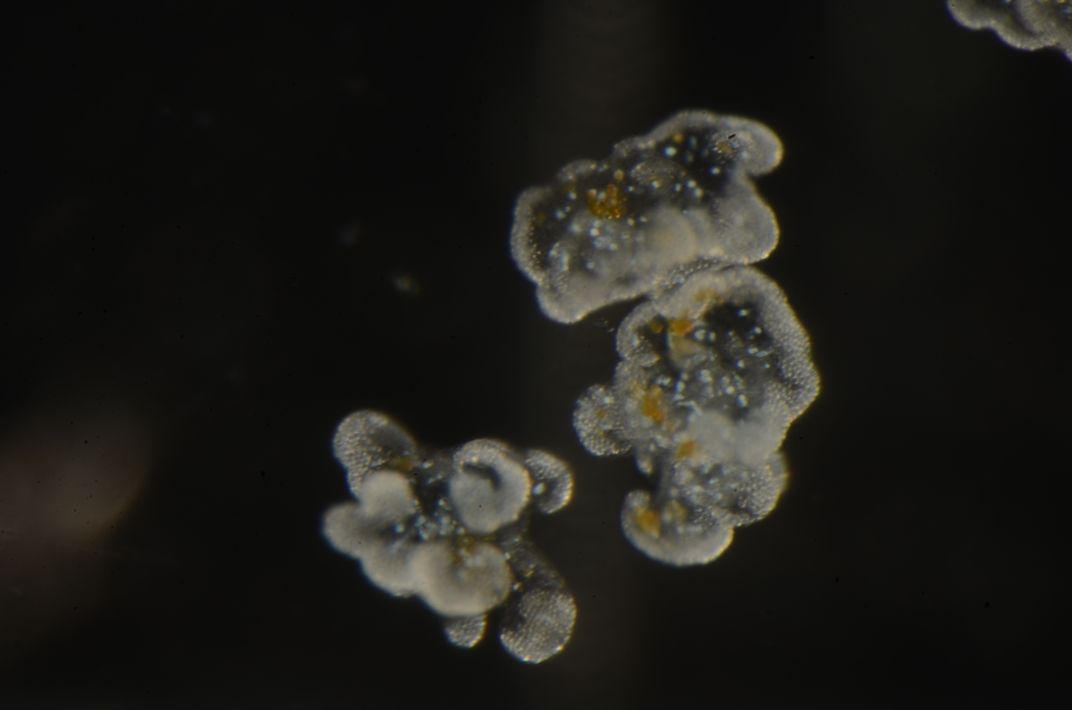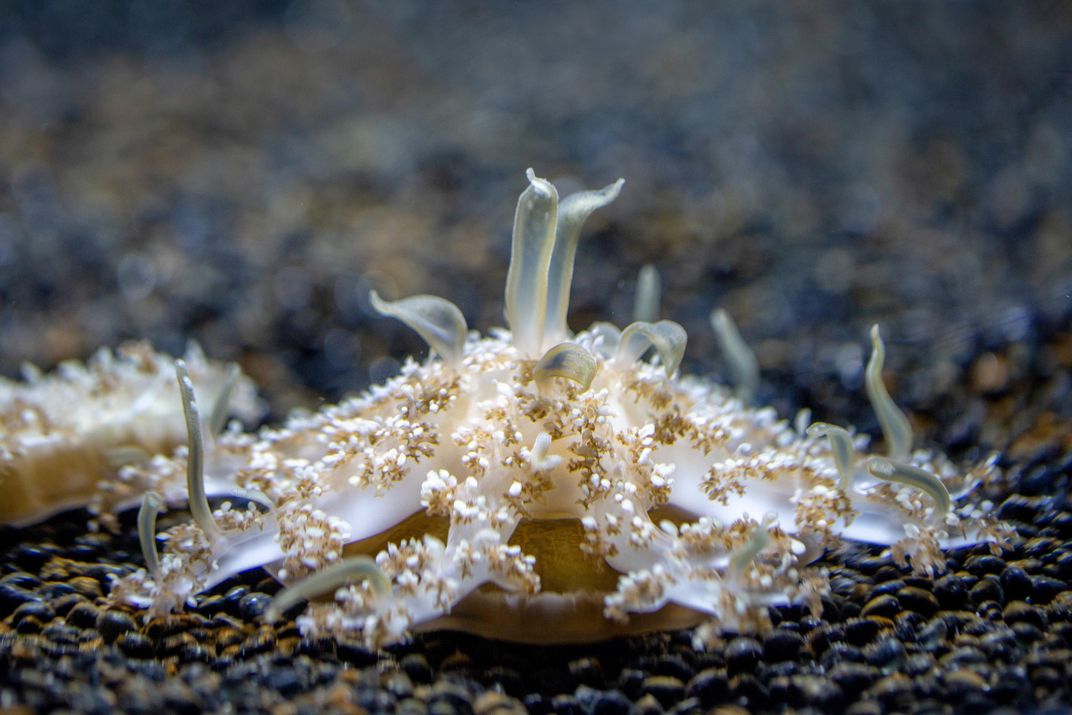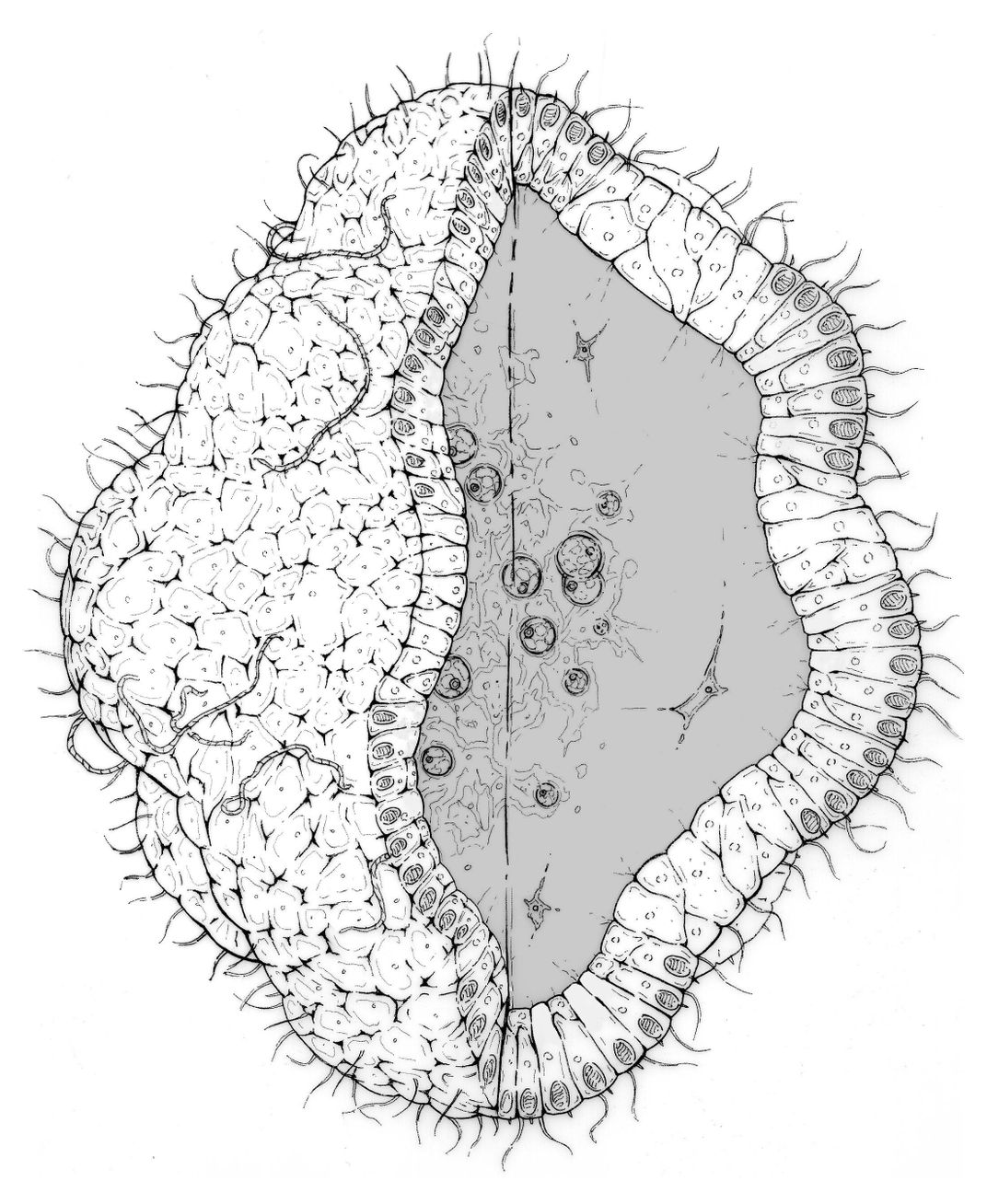These Jellyfish Don’t Need Tentacles to Deliver a Toxic Sting
Smithsonian scientists discovered that tiny ‘mucus grenades’ are responsible for a mysterious phenomenon known as ‘stinging water’
/https://tf-cmsv2-smithsonianmag-media.s3.amazonaws.com/filer/c8/a9/c8a97188-234d-462e-88ab-09c8e9d4650d/allen_collins_-_cass_stinging_snot_agc_9428.png)
A mysterious burning, itchy sensation after a swim is usually the telltale sign of a jellyfish sting.
But in coastal mangroves and other subtropical ecosystems, snorklers and swimmers have long reported a similar sensation without ever coming in contact with a jellyfish. A phenomenon called “stinging water” is to blame, but the cause is unknown.
One potential culprit is a type of jellyfish belonging to the genus Cassiopea called the upside-down jellyfish, but they are missing a key appendage normally necessary to deal a stinging blow: spaghetti-like tentacles.
Instead of a gelatinous, umbrella-shaped body with long, swaying tentacles undulating beneath as it floats through the water, Cassiopea got its common name for being the exact opposite. The soft, circular body, known as the medusa, rests on the seafloor while just a few short, tentacles float above them. Cassiopea are known to get the bulk of their energy through their symbiotic relationship with the photosynthetic algae Symbiodinium that lives within their body.
But how could the upside-down jellyfish sting something without ever coming in direct contact with their victims? These unassuming invertebrates are known to unleash plumes of mucus into the water, and though the slime was certainly a suspected cause of the irritation, scientists had never researched what elements of the slime might lead to pain before.
In a paper published today in Nature Communications Biology, researchers found that the mucus is laced with toxic bubble-like tissues covered in the same stinging cells that cause the iconic jellyfish itch.
Study coauthor Allen Collins, a NOAA invertebrate zoologist, is no stranger to this stinging sensation. While completing field work at the Smithsonian Tropical Research Institute in Panama, Collins fell victim to the so-called “stinging water” while handling the upside-down jellyfish.
“I picked up quite a bunch of them and brought them back to the lab,” Collins says. “Even though I had gloves on I was very soon uncomfortable where my skin was exposed, around my neck and my face.”
Collins has long shared his experience as a cautionary tale for students when introducing them to upside-down jellyfishes reared in the Department of Invertebrate Zoology at Smithsonian’s National Museum of Natural History. One of those students is first author of the study Cheryl Ames, now a marine biologist at Tohoku University in Japan who started this research while she was a Ph.D. researcher working with Collins at Smithsonian’s National Museum of Natural History.
Ames and several other researchers decided to view at the mucus under a microscope when they couldn’t find the stinging sensation associated with the slime in scientific literature. Upon closer look, they found that the plumes expelled by the upside-down jellyfish are loaded with tiny spheres encased in nematocysts, which are the same stinging cells jellyfish are traditionally known for.
“They’re roughly ovular, shaped like asteroids with little bumps on them,” Collins describes. “And on those bumps are where the stinging capsules are concentrated.”

Dubbed cassiosomes by the team, the capsules are covered in fine, hair-like structures known as cilia. The cilia allow the entire cassiosome to gyrate and spiral within the mucus. In a laboratory experiment, researchers found that the cassiosomes are capable of incapacitating brine shrimp, providing evidence that the jellyfish release cassiosomes to stun prey before eating them.
Cassiopea species have been known since 1775, and their mucus spewing behavior is well-described. At first, Collins thought for sure the research had already been done.
“I had always assumed that it was well explained somewhere in the literature and that we just hadn’t come across it yet,” Collins says. “When we started going into the literature, we didn’t find anything other than a couple brief asides. No one had worked this out in detail.”
The phenomenon of stinging water is not a new finding, but the discovery of the source is truly valuable, explains Leslie Babonis, a researcher at the Whitney Laboratory for Marine Bioscience.
“Think about how crazy this is – it’s energetically costly for animals to produce new cells and tissues and the upside-down jellies are just dumping huge masses of these things into the water column to deter passers-by,” says Babonis, who was not involved in this study.
This team of researchers have uncovered an entirely unknown mechanism of stings, as cassiosomes have since been found in other related jellyfish species and could be even more widespread.

Oddly enough, however, the team also found that the cassiosomes are hollow and filled with the same photosynthetic, symbiotic algae the live freely in their bodies. Because expelling mucus is so energetically costly, Collins speculates that the Symbiodinium could provide energy to the cassiosomes as well. In the lab, cassiosomes could survive in seawater for at least ten days. Why the mechanism exists remains unknown, but Collins hypothesizes about a few possibilities.
One could be that cassiosomes help to disperse Symbiodinium, which is beneficial both for the algae and the jellyfish. Cassiopea can take up the algae from the water, which is necessary for development.
"We know there's a really tight symbiosis there,” Collins says. “They can’t produce a medusa unless they have Symbiodinium in their tissues. Cassiosomes may be a way for the algae to get out and get around.”

Understanding this symbiotic relationship certainly interest biologists, but explaining “stinging water” and better understanding how marine creatures produce and disperse venomous goo may have also have wide-ranging impacts for human health. Because Cassiopeia is already recognized as a model organism, meaning the species is used in laboratory studies to better understand biological processes, this study could lead to exciting new discoveries about other jellyfish species as well.
For now, the researchers—and probably a lot of snorkelers and swimmers—are happy the “stinging water” mystery has been solved.
Hannah Knigton is an intern with the Smithsonian National Museum of Natural History's Ocean Portal.